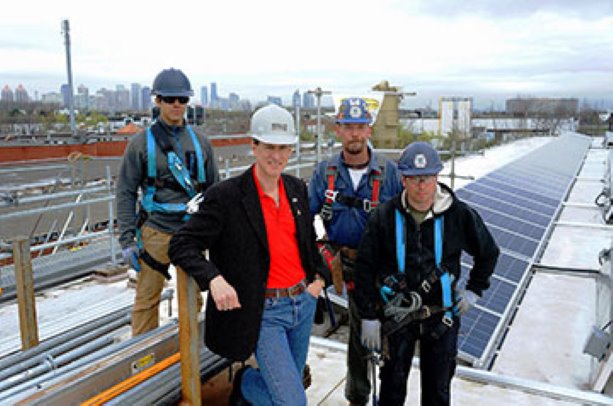As Helmets to Hardhats (H2H) celebrates its second anniversary, an ex-military vet is being placed nearly every other day into apprenticeship or career employment in the building trades in Canada, according to H2H executive director Greg Matte.
At Carpenters Local 27 in the Greater Toronto Area (GTA), about 25 armed forces vets have been placed — either as carpenter’s apprentices or journeypersons, according to Mike Humphries, Local 27 business representative and liaison with H2H.
The partnership is proving to be a success for the union, the vets and the contractors who hire them.
One of those contractors is Skyway Canada Limited, a major scaffolding contractor in the GTA. In the past few months Skyway has hired three H2H military vets through Local 27’s hiring hall.
“They have all worked out well,” says Kerry Matchem, construction manager for Skyway Canada.
He says the three are disciplined, show up on time and have a good work ethic — rationale for why Matchem will hire more H2H vets as work for the contractor ramps up over the summer.
One of the vets is Juan Sebastian Villa, who served a three-year contract with the Third Battalion of Princess Patricia’s Canadian Light Infantry, including a stint in Afghanistan.
“I always wanted to be a carpenter,” says the first-year apprentice hired a month ago.
Villa says Skyway is proving to be a good place to learn skills of the trade.
“The group of guys I work with are really solid. There’s no yelling going on — they understand that is not a way to teach.”
Just prior to leaving the military Trevor Fick was uncertain about his future. Through H2H he connected with Local 27 to land work with Skyway about three months ago. “The transition from military to civilian life was made a lot easier thanks to Helmets to Hardhats and the union.”
Fick, who plans to write his carpentry Red Seal journeyperson certification exams before year’s end, was a carpenter in Vancouver for two years prior to serving as a combat engineer in the military. In Afghanistan he built structures/residences for the troops and was responsible for clearing explosive threats for infantry.
Skyway also hired ex-military vet Wyatt Bilger, a journeyperson carpenter, whose time in the armed forces also included deployment in Afghanistan.
Rory Smith, business representative for Carpenters Local 27 who has close ties to the scaffolding sector, says scaffolding is a “good fit” for H2H vets because the work is team-based and requires crews to be “thinking on their feet.”
“It’s the fundamentals of what they’ve done in the military,” he says.
Smith adds that he sees Skyway as a recruitment leader in the scaffolding industry, not just because the company’s management values the skillsets vets bring to the job, but also because “they see it as the right thing to do . . . a moral responsibility, you could say.”
Smith says at Local 27, H2H vets are offered free training in construction skills and practices including courses on WHMIS, fall arrest, work in confined space, formwork and scaffolding courses prior to going to work.
H2H’s Matte says contractors like Skyway might be able to recruit another type of worker from the armed forces — transport truck drivers — if an initiative by the H2H is successful. The organization is working with provincial government in an effort to recognize the military licences for operation of transport trailers with heavy loads as equivalent to a commercial transport trailer operation in the civilian world.
In the military, drivers with Mobile Sport Equipment licences are trained (including on air brakes) to haul heavy loads, much like those of commercial transport operators, he says.
Matte says it is difficult to track all of the vets who have landed work in the building trades since its inception two years ago, but there are probably close to 370 who were hired in Canada within 14 unions representing 400 locals.
Typically, 4,000-6,000 veterans retire from the military annually, but many of those are 60 or over, not looking to restart their careers, he says.



Recent Comments
comments for this post are closed